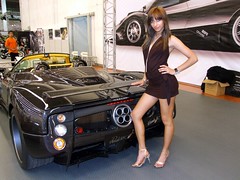This was a question that came to me today, as I was perusing an old issue of Motor Trend. And by old, I mean before I was born -- 1984, to be precise. They were testing the new-for-1984 Buick Regal T-Type with the recently introduced Grand National package. By now, of course, the Grand National is the stuff of legends -- that turbocharged, tire-smoking anomaly in Buick’s mostly boring history. It’s the Darth Vader of cars -- slightly spooky when you pull up next to one at a stop light, and your chances of winning a race against one are pretty low, unless you’re in something like a 911 Turbo. Heck, without the Grand National, the GMC Syclone wouldn’t exist -- which we all know was awesome.
Now, at the time, the Grand National had one direct competitor, and it’s a car that was extremely well-received and popular at the time, but history has gradually forgotten it’s very existance. I’m talking about the Ford Thunderbird TurboCoupe. It was the ying to the Grand National’s yang. Although both cars had some common ground -- Porsche-baiting performance with a reasonable price tag, wrapped in a distinctly American “personal coupe” body -- the execution was vastly different between the two.
The Grand National was based on GM’s “intermediate” platform, internally referred to as the G-Body, which underpinned the Monte Carlo, Regal, El Camino, Malibu, Cutlass, Bonneville, Grand Prix, and Le Mans. It was one of the last traditional mid-size platforms GM ever produced. It was body-on-frame construction, with the engine up front spinning a driveshaft that turned a pumpkin on a live axle at the back. Steering was via recirculating ball -- none of that fancy rack-and-pinion stuff. It was technically classified as a sedan, because it had a B-pillar, but it was your average 4-seat 2-door coupe. Styling was very upright and traditional, a square greenhouse plopped on a slab of body.
Many people think the Grand National was it’s own specific model. This isn’t actually the case; Grand National was just simply an option package for Regal T-Types. T-Type was a designation Buick used to signify it’s performance models in the 80′s, with monochrome trim, alloy wheels, and not a lot of glitz. Under the T-Type/Grand National’s hood beat a now-famous engine: Buick’s odd 231ci even-fire 90° V6, fitted with Bosch/Delco sequential fuel injection, direct ignition, and a big old turbocharger. For 1984, the first model year of the “real” Grand National, the V6 boasted 200 horsepower and a meaty 300 lb-ft of torque. Power was sent through a 200-R4 4-speed automatic with higher line pressure for harder shifts, a limited-slip rear axle with a 3.42:1 final drive, and out the rear tires in a cloud of smoke. Tests of early Grand Nationals without intercooling had them doing low 7-second 0-60 times and the quarter mile in 15 seconds flat, meaning they were considerably faster than a Camaro Z/28 or Firebird Formula of the time.
Buick added an air-to-air intercooler to the Grand National for 1986, upping the boost to 15psi with lower intake temperatures, and power jumped accordingly. The new intercooled Grand National made 235 horsepower and 345 lb-ft of torque, up to 245 and 355 for 1987, the last year of production. There was also the limited-production GNX built with the help of ASC MacLaren, which was the fastest accelerating production car short of the Porsche 959 back in 1987, but that’s not really what we’re covering here.
Over at Ford, the brand was going through a much-needed resurgence and modernization in the early to mid eighties. Their products were stagnant and outdated, and the overall image was stodgy and boring. The first product of their revolution was the 9th-generation “Aero Bird” Thunderbird, based on the Fox-body that underpinned most mid-sized Fords, introduced in 1983. While base versions had a wheezing Essex 3.8L V6, and you could get a slightly-less weezing 302ci Windsor V8 (140 horsepower!), the model that actually got people to notice was the TurboCoupe.
Power came from Ford’s 2.3L “Lima” inline-four, fortified with a Garrett (later IHI) turbocharger and electronic fuel injection controlled by Ford’s EEC-IV computer. This turbo 4 was the same engine shared with the Mustang SVO, Merkur XR4Ti, as well as the Mercury Cougar XR7 and Capri Turbo RS. This was a distinctly European-flavored sports coupe, at a time when American luxury cars were more about vinyl roofs, wire wheels, and squishy seats than meaningful things like performance, handling, and braking. Ford had previously sold cars with a turbo 2.3L (mostly Mustang GT’s) but they were sort of half-baked -- performance with a draw-through carb turbo setup was a bit like a light switch, and 135 horsepower was pretty weak compared to the 157bhp the dual-carb 302 was making. Electronic fuel injection took the suck out of the turbo four, smoothing out power delivery and giving it some manners.
Besides the turbo motor, Ford also focused on making the ‘Bird handle. It had stiffer shocks and springs, wider wheels with sticky tires, better seats, full analog gauges, and other goodies. Most interesting, for the first year the TurboCoupe was only available with one transmission -- a Tremec 5-speed manual. The magazines raved about the power, the agile handling, and the overall European feel of the car. Ford ads of the time claimed that the TurboCoupe was around 1 second faster around a 1.07 mile road course than the BMW 633CSi, which was about twice the price.
Ford continually improved the TurboCoupe over it’s life span. Power jumped to 155 horsepower in 1985, and there was also an available 4-speed electronically controlled automatic. The big change-over point occured for 1987, when Ford restyled the Fox-body based Thunderbird. The headlights were faired in, the nose was smoothed out, and the TurboCoupe got a heavily ventilated hood to extract heat. The 2.3L Turbo gained the top-mounted air-to-air intercooler from the Mustang SVO, and with boost upped to 17psi(!) power output totalled 190 horsepower with the 5-speed, although it was limited to 150 in the automatic for “durability reasons.” The TurboCoupe’s last year was 1988, when the Fox-based Thunderbird was replaced by the much more sophisticated MN12 Thunderbird with IRS in 1989 -- out went the turbo four, in went a super-torquey 3.8L Supercharged V6 as the top engine.
The contrast between the two was remarkable. The Grand National was a big, heavy, ponderous car with a monster of an engine. It’s especially fast in a straight line, but the traditional body-on-frame construction, vague steering, and automatic-only gearbox made it more of a drag car than a track car. The TurboCoupe didn’t have the sheer face-punching grunt of the Grand National, but it was lighter, more modern, much better through the corners, and most likely better on gas. Both were perched in between two eras of American luxury -- posted LTD but pre-SHO, if you will. They had elements of both -- powerful engines and squishy velour seats! But which is your choice of turbocharged American “personal coupe”?





















